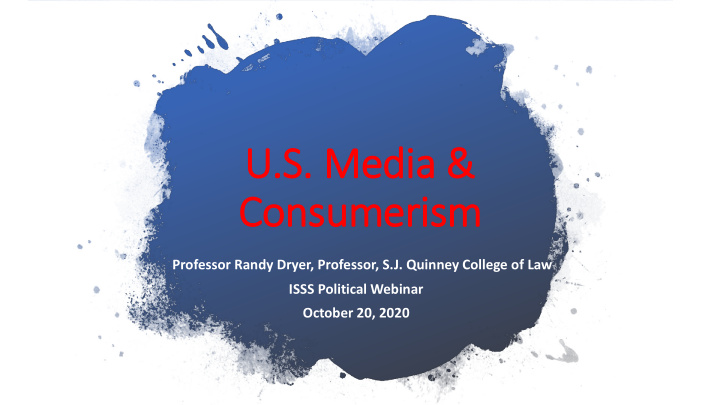



U.S. Media & a & Con Consu sumeri rism sm Professor Randy Dryer, Professor, S.J. Quinney College of Law ISSS Political Webinar October 20, 2020
1. “Fake news” Mi Misinforma mation 2. Manipulated video & audio on on S Socia ocial l Me Media (Deep fakes) Comes in M Many 3. Hoaxes or conspiracy theories Forms 4. Political ads
1. Foreign govts & organizations 2. Domestic partisan political Who S o Spreads actors Mi Misinforma mation 3. Click bait commercial outlets on on Socia ocial M l Med edia ia? 4. Social Media networks 5. Social Media users…all of us!)
1. Think before you share • Consider the source(s) • Check the author How t to Avoid • Be alert for click bait headlines Sprea eading • Check the publish date & time • Be wary of shocking quotes & Misinforma Mi mation o on photos Socia ocial M l Med edia ia 2. Be aware of your biases 3. Consult a fact-checking site 4. Use common sense & be skeptical
1. https://www.factcheck.org/ 2. https://www.politifact.com/ Th Third-party F Fact ct 3. https://www.washingtonpost.c Check ecker ers om/news/fact-checker/ 4. https://apnews.com/hub/ap- fact-check
1. First Draft https://firstdraftnews.org/ Additi tion onal 2. A 90 minute fact-checking Resou ources ces course for college students https://www.poynter.org/shop /fact-checking/handson- factchecking/
• • •
• • • •
Does currency (When?) of the document contribute to its relevance (Why? How?) and support the purpose (Why? What?) of your research? Does the authority (Who? What? Where from?) of the author and publication inspire confidence in the content’s accuracy (When? What? Where from?) and timely relevance to the topic at hand and how does all of this lend to the purpose of this document? Image source: Humber College Libraries http://libguides.humber.ca/c.php?g=489448&p=3346679
• • • • • • • • • •
Recommend
More recommend